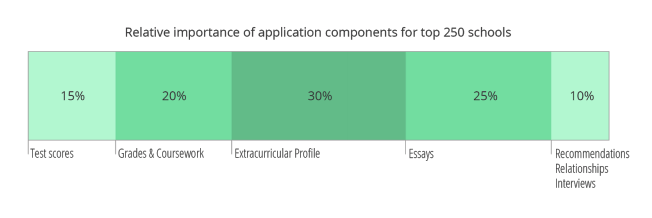Benefits of Extracurricular Activities: Why They’re So Important
It’s not all grades and test scores. When you’re applying to college, what happens outside of the classroom is just as important as what happens in it. Colleges look for students who will excel in their fields of choice. While your grades can show your aptitude in subjects, it’s the passions you pursue on your own that really demonstrate your potential in your chosen career. That’s why extracurricular activities matter so much in the college admissions process. In a nutshell, extracurriculars are activities you do outside of your coursework. However, there are academic societies and organizations that qualify as extracurriculars, such as Google Science Fair. School clubs, athletic teams, internships, theater, music groups and bands, and volunteer work are other examples of extracurriculars. Paying jobs and personal projects, such as starting a blog or teaching courses, also qualify. Colleges will see family responsibilities, like babysitting younger siblings or working in your family grocery, as activities too. Be sure to include these activities on your application, especially if they prevent you from participating in more traditional extracurriculars. With the current pandemic, extracurricular opportunities are limited, but there are many activities that you can do from home. They include online foreign language discussion groups, starting an online zine, or phone banking for politicians or fundraisers. Not everything you do outside the classroom is an extracurricular activity, though. Hobbies like reading, watching movies, or playing video games aren’t activities you should put on your applications — unless you turn them into a personal project, like writing a blog about your favorite books or shows. Nobody expects you to have your career path completely nailed down by the time you apply for college. High school is a time for exploration, and extracurricular activities allow you to facilitate that. By sampling different clubs, organizations, and projects, you’ll be able to get a sense of the kinds of things you like to do and the areas in which you excel. Even if you already have areas about which you’re passionate, extracurricular activities can help you develop, hone, and further explore them. Participating in extracurriculars allows you to further develop your talents by diving deep into a topic of interest. For example, if you serve as editor for your school newspaper, you can take these editing and writing skills into college and your career. You’ll also develop general skills like time management, perseverance, teamwork, and collaboration. When you play on a sports team, for instance, you’ll learn how to work with others toward achieving a common goal. You’ll also learn to set long-term goals for yourself (like making varsity), and build the discipline to work towards that goal daily. Top-tier schools get thousands of academically qualified applicants. Extracurriculars are essential if you’re applying to these colleges, not only because they demonstrate your interests, but also because they give your application personality. This will help you stand out among the many other candidates who have great grades and test scores. In fact, at top schools, your extracurricular profile makes up 30% of the weight of your application, which is more than any other component. Extracurricular activities provide ample opportunity to meet like-minded peers. These are people who have similar interests — or at least are interested in exploring similar topics — as you. Even in activities that aren’t necessarily your calling, you’ll be able to collaborate with other students and form bonds over shared projects. We all need a break from work. Extracurriculars not only give you that — they also provide you with a creative outlet. You’ll be able to pursue a passion and impress colleges at the same time: it’s a win-win. Research has shown time and time again that students reap many rewards from participating in extracurricular activities, including earning higher grades and test scores. This, of course, means you’ll be a more desirable candidate overall; not only will you have activities on your resume, but they will also shine through in your academic performance. If you’re not quite sure where your passions and talents lie at the beginning of high school, don’t worry. Use freshman year as a time to explore different interests. Could you be a performer? Try out for the school play. Want to make a difference in your community? Consider mentoring younger students. During ninth grade, you should be trying out different activities so you can figure out which ones you want to continue throughout high school. Once you’ve explored different interests, it’s time to narrow them down to a handful. That’s because colleges prefer to see students with well-developed extracurriculars rather than those with tons of random, unconnected activities. That doesn’t mean you should only have 1-3 activities — you should have 8-10 for competitive schools, but they should fall under a couple of main categories and themes. For example, one larger category might be music, including school orchestra, all-state orchestra, and volunteer-performing at a local nursing home. Another may be science, with activities like Science Olympiad, biology club, and a research internship. Another yet could be leadership, including participation in student government and a leadership position in one or more clubs. Activities can be divided into four tiers, with Tier 1 representing activities that are unique and exceptional and Tier 4 representing the most common and frequently seen extracurriculars. The greater the role you take in an activity, the higher the activity tier. For top 20 schools, you should aim to have at least a few Tier 1 and 2 activities. Gaining leadership positions and entering (and winning) competitions will increase the value of your activities, as well as boost the impressiveness of your profile. How does your extracurricular and academic profile compare with those of other college applicants? With our chancing engine, you’ll find out how you stack up and your odds of admission to more than 500 colleges and universities. We’ll also give you tips on how to improve your profile — all for free! Sign up for your free CollegeVine account today to get started.What Are Extracurricular Activities?
Benefits of Extracurricular Activities
1. They help students explore their passions and career interests.
2. Students develop real-life skills by participating in extracurriculars.
3. Extracurriculars strengthen your college application.

4. It’s easy to make friends through extracurriculars.
5. They provide a break from school.
6. Participation in extracurriculars is linked to higher academic performance.

How to Build Your Extracurricular Profile
1. Start by exploring a variety of interests.
2. Hone in on 1-3 interests later on.
3. Increase your leadership and responsibilities.


